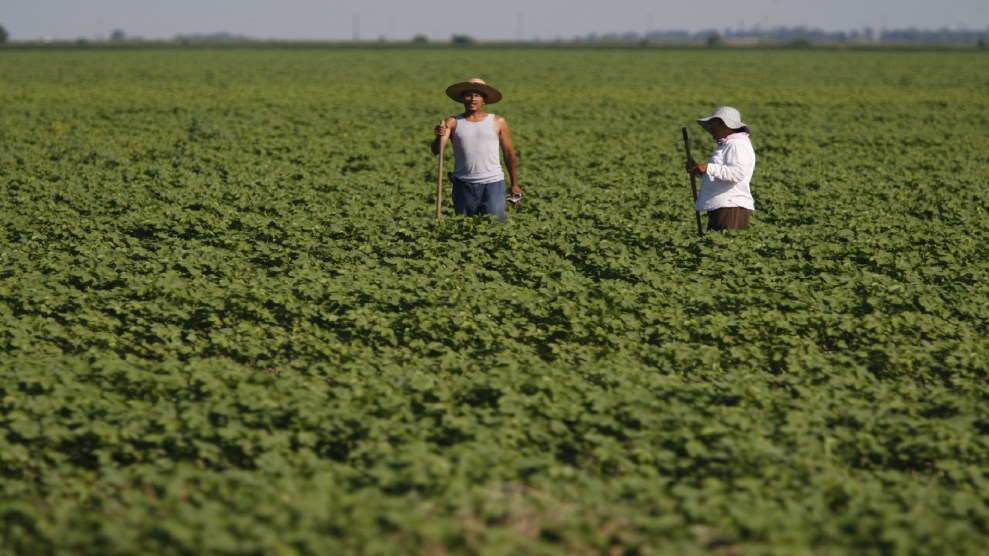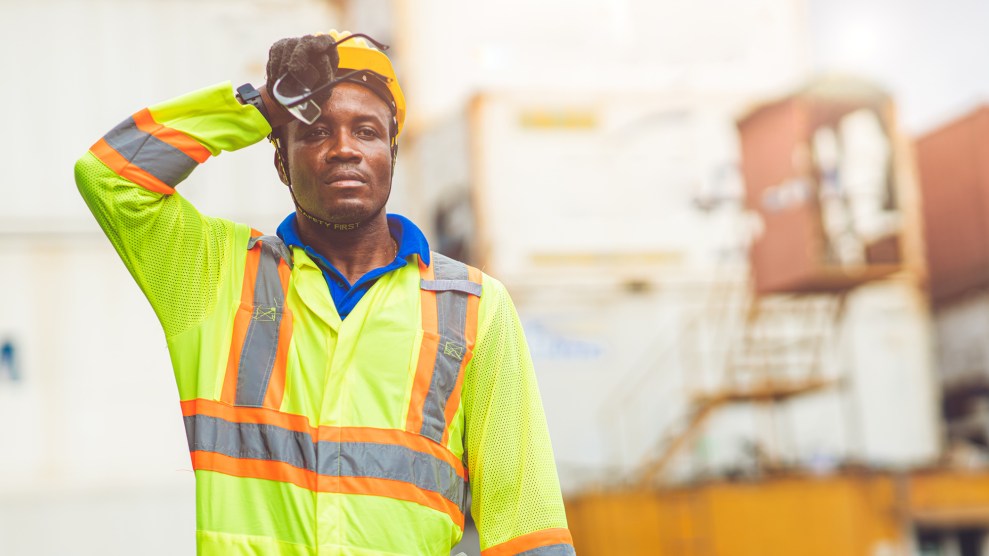
Potential OSHA heat stress rule could allow longer breaks while working in extreme heat. Karen Focht/ZUMA
This story was originally published by Grist and is reproduced here as part of the Climate Desk collaboration.
In the summer of 2011, Victor Ramirez was working in a Walmart warehouse in Mira Loma, California, when he suddenly fainted. When he came to, he was lying on the floor, confused about what had just happened, with his head aching terribly. While he didn’t receive any medical attention—his boss only told him to go home if he didn’t feel well enough to keep working—he knew that this sudden bout of unconsciousness must have been triggered by the relentless heat in the warehouse.
“When it’s hot outside, it feels even hotter within the warehouses, because of all the machinery,” Ramirez told Grist in Spanish. “If it’s like 110 outside, then it’s like 10 more degrees inside.” The heat was exacerbated by a lack of water and poor air circulation inside the warehouse.
Later that summer, he once again felt similar symptoms. He was flushed, profusely sweating, and his head was hurting. This time around, he knew these were signs of heat stress and told a supervisor, who asked Ramirez why he was “acting dumb” and questioned why he wasn’t working faster. In both instances, no one offered emergency aid or even recommended he go see a doctor. (Walmart declined to comment on Ramirez’s experience, stating that the site was operated by a third party, Schneider Logistics. A spokesperson for Schneider Logistics did not respond to Grist’s request for comment.)
“I’m nervous, for myself and my daughter,” said Ramirez, whose family relies on his wages to pay their bills. He now works at another warehouse, but the 55-year-old is constantly worried something might happen to him because of dangerous heat exposure on the job. Inadequate access to water, limited air conditioning, and cavalier attitudes about heat exposure are common in his industry. Ramirez’s fear is reignited every year when temperatures start rising and summer rolls around.
Ramirez has good reason to be concerned. Extreme heat is the deadliest extreme weather event, with a threat level that’s intensifying because of climate change. The US Bureau of Labor Statistics reports that dozens of workers die every year from workplace heat exposure, with a total of 436 deaths between 2011 and 2021, though federal officials have noted that’s widely recognized as an undercount. But no national regulation exists to shield indoor or outdoor workers from heat—a fact that has prompted Ramirez to fight for protections in Southern California, and others to advocate for stronger safeguards across the country.
“Pay attention to the workers,” Ramirez said. “We are what matters.”
As of this month, the Occupational Safety and Health Administration, or OSHA, is one step closer to creating America’s first-ever national heat stress rule for workers. The agency, which announced it would begin the process of drafting a federal heat rule three years ago, submitted a proposal on June 11 to the White House Office of Management and Budget, or OMB, for review. It’s a critical step that signals that the rule could be finalized relatively soon—but legal experts and labor advocates worry about upcoming legal, bureaucratic, and political challenges to OSHA’s rulemaking process, especially in an election year. A Trump victory in November could spell doom for any federal heat stress rule—and even without an administration change in 2025, OSHA’s rule may be subject to legal challenges in the courts.
Experts, advocates, and panels hosted by the agency suggest the standard could mandate worker and employer training on how to recognize and treat symptoms of heat stress, a process that allows workers new to an area to gradually adapt to hazardous temperatures, and a temperature threshold that triggers heat illness prevention programs that require more frequent, longer breaks. OSHA has previously stated that the rule’s mandates could begin to take effect once the heat index approaches 80 degrees Fahrenheit, Bloomberg Law reported.
Such a rule could be transformative. “OSHA regulates the entire workforce,” said Cary Coglianese, the director of the Penn Program on Regulation and a professor at the University of Pennsylvania Law School. “Heat affects every outdoor worker and some major industries—whether it’s construction, travel, transportation, I mean, you name it.”
“OSHA regulates the entire workforce. Heat affects every outdoor worker and some major industries—whether it’s construction, travel, transportation, I mean, you name it.”
According to Coliagnese, the draft proposal going to the White House marks the beginning of a review process that may take about 90 days—although it could be longer or shorter. “A lot depends certainly on how much of a push there is within the administration to get a rule out,” said Coglianese.
The White House’s Office of Information and Regulatory Affairs didn’t respond to Grist’s request for comment on when it will finish the review. A spokesperson from OSHA said in a statement, “Heat is a serious workplace hazard that threatens the health, safety, and lives of workers every year,” adding that enacting a federal heat standard is a priority for the Department of Labor. “As of Tuesday, June 11th, the proposed rule is with the Office of Management and Budget for review, and we are one step closer to giving workers the protections they need and deserve.”
When the review has concluded, details of the proposed rule will be publicized, at which point the public will be given at least a 60-day period to submit comments to the agency on the rule. Coglianese warns that a rule with such wide-reaching impacts will mean OSHA is likely to receive plenty of comments.
Once the comment period is over, OSHA will need time to reflect on and address any issues raised by the public. How long the agency takes on that “is a function of the comments that come in, of their priorities, and maybe of just how vexing some of the issues are,” said Coglianese. After OSHA has an updated draft, another White House review follows; if all goes well, the rule is then finalized and published in the Federal Register.
OSHA’s latest progress in this process is welcome news to many advocates who have invested years into fighting for heat protections—like Nezahualcoyotl Xiuhtecutli, a senior grassroots advocacy coordinator at the National Sustainable Agriculture Coalition. Xiuhtecutli participated in a working group that made recommendations to OSHA to help inform the proposed rule. But he worries the rulemaking process may drag on well beyond this year.
“It could be a few more years,” said Xiuhtecutli. “I think the Biden administration is interested in making this happen, so I hope that they hurry up and do it.”
Representative Greg Casar, a Democrat from Texas who went on a one-day thirst strike last year to call attention to the urgent need for worker protections agrees that when it comes to extreme heat, time is of the essence.
“We need this heat protection, as soon as possible. We need it yesterday,” said Casar. He added that he has confidence in the Biden administration in “getting this done right and getting it done quickly.”
But the yearslong battle wrought by workers and advocates to get a national heat standard on the table now faces a looming hurdle: the forthcoming presidential election.
In Coglianese’s opinion, it’s unlikely that the rule will be finalized before November, or even by next January. He added that, if Donald Trump takes office, he will likely put a hold on any federal rules that have not yet been finalized. Even if a federal heat rule were to “squeak through” at the end of Biden’s term, Congress would have the authority to nullify the rule under the Congressional Review Act—and Coglianese expects that Trump would approve such a nullification. (The Trump campaign didn’t respond to Grist’s request for comment.)
“[If] Biden loses the election, then it’s going to linger there indefinitely, or it could just be killed.”
Advocates share Coglianese’s concerns. “[If] Biden loses the election, then it’s going to linger there indefinitely, or it could just be killed,” said Xiuhtecutli. “I hope that it continues to move forward speedily, because people’s lives depend on it.”
Experts’ predictions about the future of the rule reflect the recent politicization of extreme heat. Earlier this year, Florida Governor Ron DeSantis enacted anti-immigrant legislation that included a law that bans municipalities from requiring employers to enact protections, such as shade or water breaks, for outdoor workers. The bill closely resembled a Texas law barring localities from creating such regulations, which passed last summer.
However, other communities have gone in the opposite direction. In Phoenix, a citywide ordinance was adopted in March mandating heat safety plans for all companies contracted by the city.
On a state level, just six states—California, Colorado, Nevada, Minnesota, Oregon, and Washington—have enacted heat protection rules for outdoor workers, while three of those states have established similar protections for indoor workers, too.
California is the latest to do so, having just passed a law to enforce heat protections for indoor workers that requires employers to provide breaks, cooling areas, and water when the indoor temperature reaches 82 degrees. If the temperature exceeds 87 degrees, companies may also be required to install cooling devices, adjust work schedules, provide more breaks, and slow down workers’ production pace. Tim Shadix, legal director at the California-based nonprofit Warehouse Worker Resource Center, describes it as the “most comprehensive” set of indoor heat protection regulations in the U.S. “Obviously when the rubber hits the road will be in how employers respond to it, and how it’s enforced,” said Shadix.
But Shadix is hoping the OSHA rule will go further than the California rule by setting lower temperature thresholds that trigger heat exposure requirements. Shadix considers California’s thresholds “way too high” and thinks a lower federal threshold “would be a very good thing for workers.”
However, Xiuhtecutli, from the OSHA working group, doesn’t expect the proposed federal rule to include a national threshold for temperatures. “They may leave that up to be determined by region,” he said. The Supreme Court on Friday overturned a 1984 decision known as the “Chevron doctrine” that allowed federal agencies to more easily regulate the environment, public health, workplace safety, and other issues. The upending of this precedent diminishes the administration’s ability to enact policy changes via federal regulations, which suggests that passing a national heat standard for workers could be open to more legal challenges.
Coglianese describes the road to finalizing a federal heat standard as “an uphill battle.” Still, in his view, the case for federal protections is becoming more and more obvious. “I think, in the long game, the heat is coming. The politicians trying to fight this are probably going to be ultimately on the losing end.”
In the meantime, he asks, “How many lives will be lost from extreme heat?” In 2023, a record 2,300 people across America died from heat-related causes, and this summer could be even hotter than the last. “I hope that we can take steps to reduce that number, and my guess is that most Americans would probably feel the same way,” said Coglianese.
















